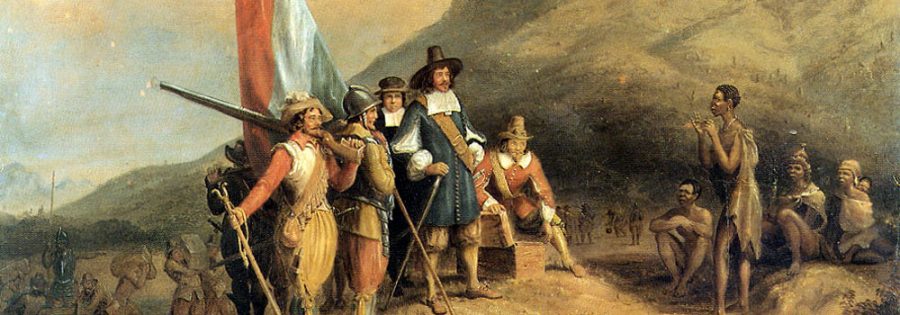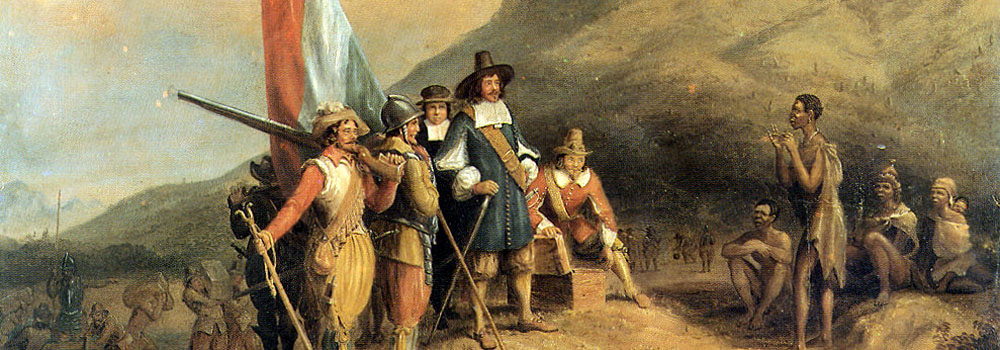
The Eight Years of Jan Van Riebeeck in South Africa
Jan Van Riebeeck arrived in South Africa in 1652. Who of my generation does not know this? It was drilled into all our minds at primary school. And even if we were not lucky enough to go to school, the mythology certainly did not pass us by. The version of history taught to us started […]

Jan Van Riebeeck arrived in South Africa in 1652. Who of my generation does not know this? It was drilled into all our minds at primary school. And even if we were not lucky enough to go to school, the mythology certainly did not pass us by. The version of history taught to us started with him. In fact if the old history books were to be believed, this was when the history of our country started… writes Zubeida Jaffer. (Today, 6 April, marks the anniversary of Van Riebeeck’s arrival.)

Who did he find at the Cape? The great leader Autshumato and his people today referred to as the KhoiSan. According to archeologists, human beings had lived here for more than a 100,000 years and as KhoiSan definitely for thousands of years.
They lived along the southern and western coastal strips, where adequate grazing was to be found. Over time they spread out into the north, intermingled with the Amaxhosa, enriching their language with their clicks.
Today there are 16 different clicks in the Xhosa language as a result of the influence of the KhoiSan whose languages were drawn from the sounds of nature. (Interestingly Madiba comes from this mix. He is maternally KhoiSan and paternally Southern African Bantu according to his DNA).
When Autshumato encountered the European delegation, he was cordial. He bartered with them and must have assumed that they were passing by as many others had done before. Instead, they had come to build a refreshment station to serve ships belonging to the Dutch East India Company.
Slowly a mutual animosity developed over access to pasteurs. Van Riebeeck and his men were settling down and pushing the KhoiSan away from adequate grazing land. The beauty of the Cape and its wealth of resources had begun to entice the visitors to stay and develop a settlement rather than just a transitory refreshment station.
The first substantial threat came after five years in 1657 when Van Riebeeck released nine men from their contracts and by royal decree granted them title deed to land along the Liesbeeck River. Each were granted 15 morgen of land in what is now known as Bishopscourt very close to the Anglican Archbishop Thabo Makgoba’s residence.Autshumato did not take this lightly and so began their 150 year resistance to prevent the Europeans from taking their land.
In that same year, 1657, Van Riebeeck’s company imported the first slaves from the Indonesian Islands and India, bringing the skill and labour that built the Cape. From them flowed some of my ancestors. Anyone keen to know more about the 176 years of slavery at the Cape should visit the Iziko Museum at the top of Adderly Street in the city. Be prepared for your stomach to turn as you witness the cruelty.
In 1659, Van Riebeeck instructed the slaves to build a wooden fence, with watch towers, from the mouth of the Salt River, through Rondebosch to Kirstenbosch, using the deeper parts of the Liesbeeck River as part of the barrier. To finish the barrier quickly, a hedge of indigenous wild almond trees (Brabejum stellatifolium) and thorny shrubs was planted along the section between the river and Kirstenbosch.
It further locked out the natives from their grazing land and access to the Salt River, the Black River and the Liesbeeck River so named by the Dutch East India Company.
Van Riebeeck recorded an encounter where they confronted him about land rights and asked him “Who should rather in justice give way, the rightful owner or the foreign intruder?” In response to this demand to withdraw, van Riebeeck said that the territory had been won in battle and now belonged to the VOC. The Khoikhoi then asked for at least the right to collect “veldkos” (bush food), specifically wild almonds (Brabejum stellatifolium) from their traditional lands.
Van Riebeeck denied this request as well. He needed the very same wild almond plants to form his barrier hedge to keep them out.
Efforts to protect the hedge began as soon as it was planted. Van Riebeeck issued a Plakaat (a posted law) forbidding everyone “not only from making passage through … the said hedge, but not even to break off from it the smallest twig, no matter what the reason is supposed to be, on pain of being banished in chains for three years”.
Today, there are only two surviving portions of van Riebeeck’s hedge, the Kirstenbosch section and another in Bishops Court. (“Beauty of the Heart” which tells the story of our first native female graduate will provide an annotation of where this information is drawn from when I publish it later this year.)
By the time Van Riebeeck left in 1662, 250 European people lived in what was beginning to look like a developing colony marking clear exclusion of the native people. In just eight years at the Cape, he had sown the seeds of a division that continues to harm us till this day.
In Kirstenbosch, the botanical gardens on the slopes of Table Mountain, where a part of that hedge still grows, this story of exclusion is not mentioned in its official brochure.
It refers to an almond hedge known for its thorns as the remains of the original hedge named Van Riebeeck’s Hedge.
The brochure fails to explain its real purpose as outlined above and its effect of denying natives access to land and water they held to be sacred. From the settler point of view, the barrier was created to prevent them from raiding their livestock, often traded from the Khoisan.
After bringing major disruption to this part of the world, Van Riebeeck continues to be presented as one whom we should value. His statue occupies centre stage at the foot end of Adderley Street, the main street in the our city. He spent eight years of his life on these shores and we hold him up as an example to our children who know nothing about Autshumato, the great KhoiSan leader.
He was an employee of a marauding company not known for fair trade outside Europe. Not very different from some companies today who parachute into our country, strip us of our resources and then fly back from whence they come. Twenty years after democracy, we need to carefully consider how we want to do business with the world. Perhaps we have little room to choose because of the great unfairness of the world economic system. But let us be aware of those who are doing us harm both from amongst ourselves and from abroad and expose exploitation where ever we see it.
It is unfortunate that the City of Cape Town chooses not to teach us to value Autshumato and others like him who has done us no harm. Instead it gives pride of place to those who have done us great harm and seems determined to help us adjust to a version of history that can only be described as a gross distortion. Failure to interrogate this attitude will only leave most citizens unsupported in making sense of their past and their present experiences.
This story first appeared on The Journalist.
***

Did you know? “The well known portraits of Jan and Maria van Riebeeck are in fact not the Van Riebeecks at all, but the Vermuyden-kettinghs. The face on the previous South African note, too (see pic), was not Van Riebeeck’s but Vermuyden’s. This authentic painting of Van Riebeeck is from De Stichter by E.C. Godee Molsbergen. No image of Maria van Riebeeck exists. ‘Her’ statue in Cape Town in fact shows the wife of the chairman of the Dutch committee that helped to organise the 1952 Van Riebeeck festival in Cape Town.” – SAHistory.org.za
AfriForum commemorated today with the following post:
https://www.facebook.com/AfriForumNasionaal/photos/a.196845757013998.51587.136542513044323/1856098144422076/?type=3
